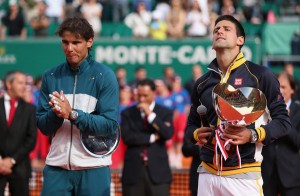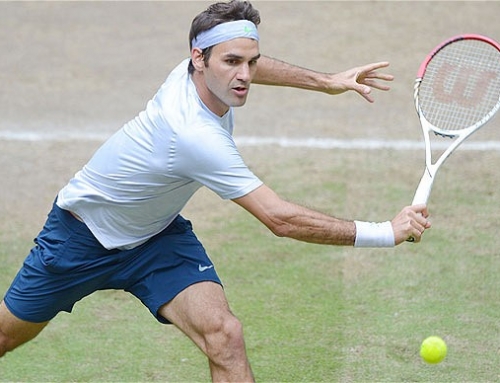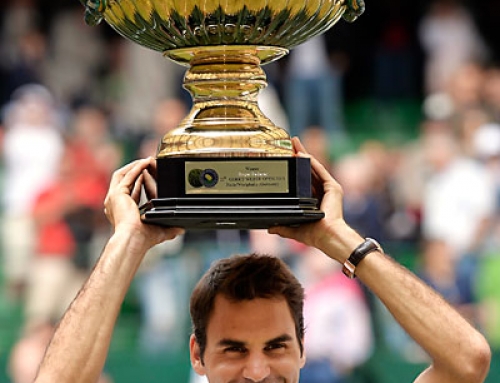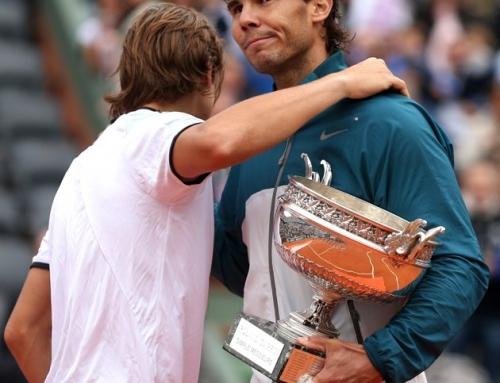 With Andy Murray withdrawing days before the start of the French Open, Roger Federer suddenly moved to the second seed, and that meant he didn’t have to see Novak Djokovic until the finals. As the third seed, he could have met both Djokovic and Nadal to win an elusive French. But with Nadal as the third seed, that possibility was still real. The big question? Which half would Nadal land in? And, it turns out, he’s in Djokovic’s half. This leaves David Ferrer, now the fourth seed, in Federer’s half, and with this turn of events, Federer has his best chance to reach a Slam final, and may not have to play Nadal at all.
With Andy Murray withdrawing days before the start of the French Open, Roger Federer suddenly moved to the second seed, and that meant he didn’t have to see Novak Djokovic until the finals. As the third seed, he could have met both Djokovic and Nadal to win an elusive French. But with Nadal as the third seed, that possibility was still real. The big question? Which half would Nadal land in? And, it turns out, he’s in Djokovic’s half. This leaves David Ferrer, now the fourth seed, in Federer’s half, and with this turn of events, Federer has his best chance to reach a Slam final, and may not have to play Nadal at all.
Let’s quick start with favorites. Despite being seeded third and ranked fourth in the world, Nadal is now considered the favorite to win the French. There are two big reasons. First, he’s won six of eight tournaments he’s played and reached the final of every event. This includes winning three clay titles in Barcelona, Madrid, and Rome. The second reason is that Rafa is still mostly undefeated at the French, with the sole blip being Robin Soderling in the fourth round of the 2009 French Open.
However, if there’s one guy that has a realistic chance of beating Rafa, it’s Djokovic, who was Rafa’s biggest rival (even before 2011) on clay. One of the losses Rafa had on clay was against Djokovic in this year’s Monte Carlo final where Djokovic, running on a gimpy ankle, managed to take control of the second set despite Rafa’s attempts to push it to a third set. Rafa, at the time, wasn’t too discouraged despite one of the biggest streaks in any one tournament at Monte Carlo. Rafa was attempting his 9th consecutive Monte Carlo title when Djokovic played great tennis to beat Rafa.
Since then, Rafa has upped his level of aggression, and Djokovic has wisely avoided meeting him. Djokovic lost to Dimitrov in Madrid, then lost to Berdych in a match he was totally in control of to avoid a semifinal showdown with his Mallorcan rival.
In my mind, Djokovic believes he can beat Rafa. That mental edge he built during 2011 was huge, and he still believes he can beat Rafa. Having said that, Rafa has come into 2013 with one goal: to beat Djokovic. If he can beat Djokovic, he can beat anyone. Rafa showed this by beating David Ferrer, forcing him corner to corner. Rafa is a strange player by modern standards. Many folks play all out aggression, and pay for it in errors. The clearest example is Rafa’s countryman, Fernando Verdasco, who doesn’t know how to play a nice conservative match. He goes for it. He make errors. And sometimes too many.
Rafa is that mama dog taking care of her brood. She runs until cornered, then she becomes aggressive. Rafa plays conservative tennis if he’s scared, but if you corner him, he’s ready to fight. Gulbis was just that player to bring Rafa to the fight as it appeared he might crush Rafa in Rome. Rafa upped his level, and Gulbis regressed back some making some errors, and Rafa escaped with another win. When he played Djokovic, he played competitively when he went for his shots. When he backed off and played conservative, Djokovic took the lead.
Having said that, Djokovic has had time to look at what Rafa has been doing, and has had a week or so to plan how he needs to play against Rafa should they meet in a blockbuster semi.
—
So let’s take a look at the draw.
Djokovic has a pretty tough draw, really. This is the way tennis goes. In another sport, say, NBA basketball, they would give the top seed every break by giving easy players all the way. Not tennis. Tennis gives you some protection, but does not afford the number 1 seed more protection than number 2. Thus, he opens up with David Goffin who had a breakout 2012, but has been playing indifferently in 2013. Had they played in 2012, it might have been interesting, but I think Djokovic takes this handily.
The second round could be the tough Croatian Dodig, or Pella just reached the semis of Dusseldorf losing a close match to Monaco. Should he play Pella, he gets a Rafa-lite, a lefty Argentine who had to qualify to get into Dusseldorf. The downside is playing too much tennis heading into Paris, but these are early rounds, and there will be some incentive to win at least one round. Dimitrov is a potential third round opponent, but he has to play Falla, who gave Federer all he could handle at Wimbledon a few years ago.
In Djokovic’s section, there is also up-and-comer Jiri Vesely, who was a top junior, but like many his age, struggling to move up the teen-scarce upper echelons of tennis. Tomic, Dolgopolov, and Kohlschreiber are in this part of the draw that is not so bad until one of them reaches Djokovic in a potential fourth round match.
In Section 2, the top seed is the struggling Tipsarevic who opens with the wildcard, Nicolas Mahut, who is probably comfortable on a faster surface despite being French. Several Americans are in this section, including Isner, Sock, Harrison. This section seems mostly pretty nice, and is open to anyone who wants to take it. Seeds include Tipsarevic, Haas, Isner, and Youzhny.
Section 3 is where Rafa is the top seed. He opens with Daniel Brands who has had a solid 2013, and can try to relive the memory of the 2010 Wimbledon where he pushed Rafa to 5 sets on grass. Brands is a big hitter, though he’s not expected to pose a big problem. His second round opponent is likely to be Klizan who played well in 2012, but like, say, Goffin, hasn’t been spectacular in 2013. Fognini is likely the biggest threat with a potential 3rd round match, but Lukas Rosol, who has steadily climbed on the ranks could also be there too.
Nishikori and Paire and the next duo, both of whom have played well on the clay, so it kinda sucks they are in the same section as Rafa rather than in Section 2 which has players that are beatable. Paire opens with the tough Baghdatis, and that could be an upset, though Paire is playing the much better tennis at the moment with a semifinal result at Rome.
Section 4 has Richard Gasquet as top seed, but Stan Wawrinka is in this section too. Stan opens up against de Bakker who played well a few years ago, but appears to have disappeared in the last year or so. Gasquet opens against the quirky Stakhovsky who might feel better on a faster surface. Both one-handers likely to get past tough-ish openers. Janowicz and Mayer are also seeded in this section. Janowicz opens with Albert Ramos a tough clay courter.
Now we head to bottom half of the draw, in Section 5.
Berdych and Almagro, best buddies, are in this section as their top seeds. Berdych opens up with a tough with Gael Monfils, a wildcard. Monfils has played rather poorly the last month or so as he’s tried to get back on tour. This is probably due to lack of practice and stamina. However, this week, he’s reached the finals of Nice. The question is how ready he is to play two weeks of clay tennis. Still, a tough first round opener for Berdych who has been playing very good, yet not quite great, tennis this year.
And then there’s Gulbis who might play Berdych in the second round. Alas, despite some good play in Rome, Gulbis is not in the top 33 or so, and comes in unseeded. Gulbis upset Berdych in the opening round at 2012 Wimbledon losing in three tiebreaks. Still, it’s a tough match for both players. Gulbis is the bigger hitter, and better mover, but Berdych is no slouch himself, and made the semis a few years ago. Almagro’s section is much nicer, and he should be expected to get to the fourth round without too much trouble. The steady Seppi is the other seed in Almagro’s section.
Section 6’s top seed is David Ferrer. The other seeds in his section are Kevin Anderson, Marcel Granollers and Milos Raonic. Anderson has had a pretty solid clay outing, surprising for the tall South African used to playing on faster surfaces. He’s struggled to beat Berdych in two consecutive clay tournaments, but the draw has put that player in Section 5 with a minefield of tough players before the two could actually meet, and really, Ferrer poses the bigger problem. Ferrer benefits greatly by Murray’s withdrawal getting his own quarter, and better than that, he can’t meet Rafa until the finals.
Ferrer has a few Spaniards in his section including Lopez, Granollers, and Montanes, but should be favored to get to the quarterfinals.
Section 7 is lead by Tsonga as its top seed, but also includes Cilic, Monaco, and Chardy. Kyrgios, a top former junior, is the top wildcard in that section. There are a lot of solid if not superior players in this section including Bedene, Nieminen, Bautista Agut, and Troicki.
Finally, Section 8 is lead by Roger Federer. His opening round is against Carreno-Busta. This Spaniard reached the semis of Portugal and won 6 Futures events in 2013 alone. He appears to be a Spaniard on the rise. Despite that, Federer is going to be heavily favored to beat this up-and-comer. The second round should be nicer as Federer might play Devvarman or Munoz de la Nava. Benneteau could be a third round opponent. The Frenchman pushed Federer to 5 sets last year at Wimbledon. However, maybe Berankis might make some noise.
Gilles Simon is in the section along with Sam Querrey. The interesting qualifier is Denis Kudla who may be better than Jack Sock in terms of quality of play. Federer has the easier half, and things don’t heat up until maybe the fourth round, but he’ll be favored then. Tsonga would be the more interesting quarterfinal opponent.
While this draw isn’t nearly as friendly as the 2012 Wimbledon draw, Federer still has to be relieved that he can only face one of Djokovic or Nadal, though he’d be the first to tell you that there’s a lot of tennis between where he is and the finals, and none of the other players in the way are planning on losing.






![[French Open] The tactics of the Djokovic-Nadal semifinals](https://www.essentialtennis.com/wp-content/uploads/2013/06/20130607nole-500x383.jpg)
![[French Open, SF] David Ferrer defeats Tsonga in straight sets to reach first Slam final](https://www.essentialtennis.com/wp-content/uploads/2013/06/20130607ferrer-500x383.jpg)